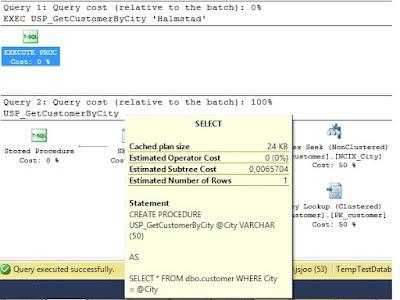Explanation
From my experience the problem often occurs on SQL statements where there is a column in the WHERE clause with very different amounts of data. Below is an example of a simple table call dbo.customer. We have a big difference in the amount of records between the cities values.
City Count
Halmstad 1000000
Kiruna 1
London 100
Paris 10
To get the
data the SQL engine chooses a different approach, if it is a low selectivity or
a high one. The city named Kiruna, use a Key Lookup, but for Halmstad a Clustered
Index Scan is the best choice.
SELECT
* FROM dbo.customer WHERE City = 'Kiruna'
SELECT * FROM dbo.customer WHERE City = 'Halmstad'
If we
create a stored procedure for this SELECT statement instead, we will probably
see issues with parameter sniffing.
CREATE
PROCEDURE USP_GetCustomerByCity @City VARCHAR(50)
AS
SELECT
* FROM dbo.customer WHERE City = @City
If
we now run this stored procedure with the high selectivity value for city Kiruna
it will be compiled with this particular SELECT statements query plan, which
use a Key Lookup. Then if we change and run the procedure with the low
selectivity value for the City Halmstad it still compile with the first value.
This even if a Clustered Index Scan would perform better. You can also see that
SQL assume it is one row with this value, see “Estimated Number of Rows”.
If the SQL
had run a Clustered Index Scan instead of a Key Lookup, which it should have
done with correct compilation, we should have seen a dramatic difference in the
reads, as you can see from the output from Statistics IO. First with a
Clustered Index Scan and second with a Key Lookup.
Table
'customer'. Scan count 1, logical reads 7316
Table
'customer'. Scan count 1, logical reads 3002730
Find the problematic stored procedures
So how is
it possible to troubleshoot this and find the stored procedures who perform badly?
Unfortunately, there is no place just to check this in an easy way in SQL.
In one approach to try finding out which
procedure suffers or should possible suffer from parameter sniffing; we are
interested in queries with big difference in the logical reads. In the DMV sys.dm_exec_query_stats
SQL collects information about queries. This DMV has the information from all
the queries in the cache. How many times they have executed, amount of rows
returned and so on. In this case, we can get use of the MIN and MAX logical
reads done for our query. Let us run the statement below.
SELECT
qs.execution_count,
SUBSTRING(qt.text,qs.statement_start_offset/2
+1,
(CASE WHEN qs.statement_end_offset =
-1
THEN
LEN(CONVERT(nvarchar(max), qt.text)) * 2
ELSE qs.statement_end_offset end
-
qs.statement_start_offset
)/2
) AS query_text,
qs.last_logical_reads,
qs.max_logical_reads,
qs.min_logical_reads,
qs.total_logical_reads
FROM
sys.dm_exec_query_stats AS
qs
CROSS
APPLY sys.dm_exec_sql_text(qs.sql_handle) AS qt
WHERE
qt.text like '%USP_GetCustomerByCity%'
ORDER
BY qs.execution_count
DESC;
This returns the information about this
examples particular procedure, and it says it has been executed seven times,
and the Max_logical_read is 3002734 compared to the Min_logical_read that is 6.
It is quite a big difference, and it reflects the information I received by
Statistics IO quite good, when I did run the SELECT statements outside the
procedure in the first run.
Workarounds
One way to solve the problem, as I have find myself
doing often, is to run EXEC
SP_UPDATESTATS. Probably not the best way to solve it, but it
often works since it also triggers a recompile of stored procedures. Often you
are in hurry and not sure if maybe the statistics is bad, which is a common
problem as well. However, a correct solution would of course be to code the
procedure correctly instead. There are a few ways to do it, as described in short
here.
Create the
procedure with the option “WITH RECOMPILE”
CREATE PROCEDURE
[dbo].[USP_GetCustomerByCity] @City VARCHAR(50)
WITH
RECOMPILE
AS
SELECT
* FROM dbo.customer WHERE City = @City;
Create the
procedure with the option “OPTIMIZE FOR” as the example below. I think this is
the best approach in newer versions of SQL.
CREATE PROCEDURE
[dbo].[USP_GetCustomerByCity] @City VARCHAR(50)
AS
SELECT
* FROM dbo.customer WHERE City = @City
OPTION
(OPTIMIZE FOR
(@City =
'Halmstad'))
This option
can be useful when you can´t change the procedure. By create a Plan Guide for
the procedure you can set the options there instead of changing the procedure.
If the parameter values are known while compiling the stored procedure,
the optimizer uses the statistics histogram and generate the best plan for the
parameters. When we define local variables and use that in the query, the SQL
server will not be able use the parameter values to find the optimal value. In
this scenario, the optimizer uses density vector information of the statistics,
and it will generate the same execution plan for all input parameters.
CREATE PROCEDURE
[dbo].[USP_GetCustomerByCity] @City VARCHAR(50)
AS
DECLARE
@LocalVariable VARCHAR(50) = @City
SELECT
* FROM dbo.customer WHERE City = @LocalVariable
Conclusion
Even if this is a quite common problem, I see
that many developers are not aware about this and how SQL works. To find the
problem procedures you have to dig into the plan_cache, and it is quite
difficult to find the problem. I think and hope the query_store in SQL 2016 can
be useful to trouble shoot this kind of problem. I will try it out when it is
more available.


